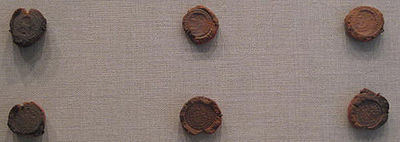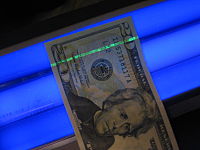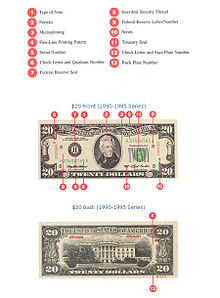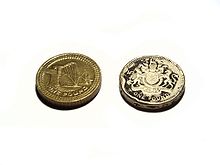- Counterfeit money
-
See also: Coin counterfeiting and Slug (coin)
Counterfeit money is currency that is produced without the legal sanction of the state or government to resemble some official form of currency closely enough that it may be confused for genuine currency. Producing or using counterfeit money is a form of fraud or forgery.
Counterfeiting is probably as old as money itself. Before the introduction of paper money, the most prevalent method of counterfeiting involved mixing base metals with pure gold or silver. A form of counterfeiting is the production of documents by legitimate printers in response to fraudulent instructions. During World War II, the Nazis forged British pounds and American dollars. Today some of the finest counterfeit banknotes are called Superdollars because of their high quality, and likeness to the real US dollar. There has been a considerable amount of counterfeiting of Euro banknotes and coins since the launch of the currency in 2002.
Some of the ill-effects that counterfeit money has on society are:[1][2] a reduction in the value of real money; and increase in prices (inflation) due to more money getting circulated in the economy - an unauthorized artificial increase in the money supply; a decrease in the acceptability of paper money; and losses, when traders are not reimbursed for counterfeit money detected by banks, even if it is confiscated.
Traditionally, anti-counterfeiting measures involved including fine detail with raised intaglio printing on bills which allows non-experts to easily spot forgeries. On coins, milled or reeded (marked with parallel grooves) edges are used to show that none of the valuable metal has been scraped off.
Contents
History
Counterfeiting is as old as money itself. Coinage of money began in the Greek city of Lydia around 600 B.C. Before the introduction of paper money, the most prevalent method of counterfeiting involved mixing base metals with pure gold or silver. A common practice was to "shave" the edges of a coin. This was known as "clipping." While not itself counterfeiting, the exponents were able to use these precious metal shavings to create counterfeits. A fourrée is an ancient type of counterfeit coin, in which a base metal core has been plated with a precious metal to resemble its solid metal counterpart. Rulers often dealt very harshly with the perpetrators of such deeds. In 1162, Emperor Gaozong of Song had promulgated a decree to punish the counterfeiter of Huizi to death and to reward the informant.[3] The English couple Thomas and Anne Rogers were convicted on 15 October 1690 for "Clipping 40 pieces of Silver." Thomas Rogers was hanged, drawn and quartered while Anne Rogers was burnt alive. Evidence supplied by an informant led to the arrest of the last of the English Coiners "King" David Hartley, who was executed by hanging in 1770. The extreme forms of punishment were meted out for acts of treason against state or Crown, rather than simple crime.
Both in the United States, and England, counterfeiting was once punishable by death. Paper currency printed by Benjamin Franklin often bore the phrase "to counterfeit is death."[4] The theory behind such harsh punishments was that one who had the skills to counterfeit currency was considered a threat to the safety of the State, and had to be eliminated - another explanation is the fact that issuing money that people could trust was both an economic imperative, as well as a (where applicable) Royal prerogative - therefore counterfeiting was a crime against the state or ruler itself, rather than against the person who received the fake money. Far more fortunate was an earlier practitioner of the same art, active in the time of the Emperor Justinian. Rather than executing Alexander the Barber, the Emperor chose to employ his talents in the government's own service.[citation needed]
Modern counterfeiting begins with paper money. Nations have used counterfeiting as a means of warfare. The idea is to overflow the enemy's economy with fake bank notes, so that the real value of the money plummets. Great Britain did this during the Revolutionary War to reduce the value of the Continental Dollar. The counterfeiters for the British were known as "shovers," presumably for the ability to "shove" the fake currency into circulation. Two of the most well-known shovers for the British during the Revolutionary War were David Farnsworth and John Blair. They were caught with 10,000 dollars in counterfeits when arrested.[5] George Washington took a personal interest in their case and called for them to be tortured to discover further information. They were eventually hung for their crimes.[6] Although this tactic was also employed by the United States during the American Civil War, the fake Confederate currency it produced was of superior quality to the real thing.[citation needed]
Instances
 An 18th century Pennsylvania Four Pound Note warns of the death penalty for counterfeiting
An 18th century Pennsylvania Four Pound Note warns of the death penalty for counterfeiting
A form of counterfeiting is the production of documents by legitimate printers in response to fraudulent instructions. An example of this is the Portuguese Bank Note Crisis of 1925, when the British banknote printers Waterlow and Sons produced Banco de Portugal notes equivalent in value to 0.88% of the Portuguese nominal Gross Domestic Product, with identical serial numbers to existing banknotes, in response to a fraud perpetrated by Alves dos Reis. Similarly, in 1929 the issue of postage stamps celebrating the Millennium of Iceland's parliament, the Althing, was compromised by the insertion of "1" on the print order, before the authorised value of stamps to be produced (see Postage stamps and postal history of Iceland.)[citation needed]
In 1926 a high-profile counterfeit scandal came to light in Hungary, when several people were arrested in the Netherlands while attempting to procure 10 million francs worth of fake French 1000-franc bills which had been produced in Hungary; after 3 years, the state-sponsored industrial scale counterfeit operation had finally collapsed. The League of Nations' investigation found Hungary's motives were to avenge its post-WWI territorial losses (blamed on Georges Clemenceau) and to use profits from the counterfeiting business to boost a militarist, border-revisionist ideology. Germany and Austria had an active role in the conspiracy, which required special machinery. The quality of fake bills was still substandard however, owing to France's use of exotic raw paper material imported from its colonies.[citation needed]
During World War II, the Nazis attempted to implement a similar plan (Operation Bernhard) against the Allies. The Nazis took Jewish artists in the Sachsenhausen concentration camp and forced them to forge British pounds and American dollars. The quality of the counterfeiting was very good, and it was almost impossible to distinguish between the real and fake bills. The Germans could not put their plan into action, and were forced to dump the counterfeit bills into a lake. Most of the bills were not recovered until the 1950s.[7]
Today the some of the finest counterfeit banknotes are called Superdollars because of their high quality, and likeness to the real US dollar. The source of the supernotes is disputed, with North Korea being vocally accused by US authorities. Recently, on May 23, 2007, the Swiss government has raised some doubt as to the ability of North Korea to produce the "Superdollars". Bulgaria and Colombia are also significant sources of counterfeit currency.[citation needed] The amount of counterfeit United States currency is estimated to be less than $3 per $10,000, with less than $3 per $100,000 difficult to detect.[8]
There has been a rapid growth in the counterfeiting of Euro banknotes and coins since the launch of the currency in 2002. In 2003, 551,287 fake euro notes and 26,191 bogus euro coins were removed from EU circulation. In 2004, French police seized fake 10 euro and 20 euro notes worth a total of around €1.8 million from two laboratories and estimated that 145,000 notes had already entered circulation.[citation needed]
In the early years of the 21st century, the United States Secret Service has noted a substantial reduction in the quantity of forged U.S. currency, as counterfeiters turn their attention towards the Euro.[citation needed]
Further information: Counterfeit United States currencyEffect on society
Some of the ill-effects that counterfeit money has on society are:[1][2]
- Reduction in the value of real money
- Increase in prices (inflation) due to more money getting circulated in the economy - an unauthorized artificial increase in the money supply
- Decrease in the acceptability (satisfactoriness) of money - payees may demand electronic transfers of real money or payment in another currency (or even payment in a precious metal such as gold)
- Companies are not reimbursed for counterfeits. This forces them to increase prices of commodities
At the same time, in countries where paper money is a small fraction of the total money in circulation, the macroeconomic effects of counterfeiting of currency may not be significant. The microeconomic effects, such as confidence in currency, however, may be large.[9]
Anti-counterfeiting measures
Traditionally, anti-counterfeiting measures involved including fine detail with raised intaglio printing on bills which would allow non-experts to easily spot forgeries. On coins, milled or reeded (marked with parallel grooves) edges are used to show that none of the valuable metal has been scraped off. This detects the shaving or clipping (paring off) of the rim of the coin. However, it does not detect sweating, or shaking coins in a bag and collecting the resulting dust. Since this technique removes a smaller amount, it is primarily used on the most valuable coins, such as gold. In early paper money in Colonial North America, one creative means of deterring counterfeiters was to print the impression of a leaf in the bill. Since the patterns found in a leaf were unique and complex, they were nearly impossible to reproduce.[4]
In the late twentieth century advances in computer and photocopy technology made it possible for people without sophisticated training to copy currency easily. In response, national engraving bureaus began to include new more sophisticated anti-counterfeiting systems such as holograms, multi-colored bills, embedded devices such as strips, microprinting and inks whose colors changed depending on the angle of the light, and the use of design features such as the "EURion constellation" which disables modern photocopiers. Software programs such as Adobe Photoshop have been modified by their manufacturers to obstruct manipulation of scanned images of banknotes.[10] There also exist patches to counteract these measures.
For U.S. currency, anti-counterfeiting milestones are as follows:
- 1996 $100 bill gets a new design with a larger portrait
- 1997 $50 bill gets a new design with a larger portrait
- 1998 $20 bill gets a new design with a larger portrait
- 2000 $10 bill and $5 bill get a new design with a larger portrait
- 2003 $20 bill gets a new design with no oval around Andrew Jackson's portrait and more colors
- 2004 $50 bill gets a new design with no oval around Ulysses S. Grant's portrait and more colors
- 2006 $10 bill gets a new design with no oval around Alexander Hamilton's portrait and more colors
- 2008 $5 bill gets a new design with no oval around Abraham Lincoln's portrait and more colors
- 2010 $100 bill gets a new design with no oval around Benjamin Franklin's portrait and more colors
The redesigned $100 bill was unveiled on April 21, 2010, and the Federal Reserve Board will begin issuing the new bill on February 10, 2011.
The Treasury had made no plans to redesign the $5 bill using colors, but recently reversed its decision, after learning some counterfeiters were bleaching the ink off the bills and printing them as $100 bills. The new $10 bill (the design of which was revealed in late 2005) entered circulation on March 2, 2006. The $1 bill and $2 bill are seen by most counterfeiters as having too low of a value to counterfeit, and so they have not been redesigned as frequently as higher denominations.
In the 1980s counterfeiting in the Republic of Ireland twice resulted in sudden changes in official documents: in November 1984 the £1 postage stamp, also used on savings cards for paying television licences and telephone bills, was invalidated and replaced by another design at a few days' notice, because of widespread counterfeiting. Later, the £20 Central Bank of Ireland Series B banknote was rapidly replaced because of what the Finance Minister described as "the involuntary privatisation of banknote printing".
In the 1990s, the portrait of Chairman Mao Zedong was placed on the banknotes of the People's Republic of China to combat counterfeiting, as he was recognised better than the generic designs on the renminbi notes.
In 1988 The Reserve Bank of Australia, released the world's first long lasting and counterfeit resistant polymer (plastic) banknotes with a special Bicentennial $10 note issue, the problems discovered were addressed and in 1992 a problem free $5 note was issued. In 1996 Australia became the first country to have a full series of circulating polymer banknotes.[11] On 3 May 1999 the New Zealand Reserve Bank started circulating polymer banknotes printed by Note Printing Australia Limited.[12] The technology developed is now used in 26 countries.[13] Note Printing Australia is currently printing polymer notes for 18 countries.[14]
The Swiss National Bank has a reserve series of notes for the Swiss Franc bill, in case widespread counterfeiting were to take place.
List of notable counterfeiters
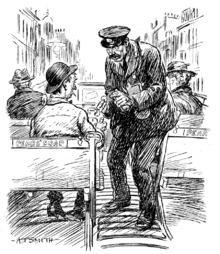 "Look 'ere—this arf-crown won't do, it's got no milling on its hedge." "Blimy! Nor it 'as! I knew I'd forgotten somefink."
"Look 'ere—this arf-crown won't do, it's got no milling on its hedge." "Blimy! Nor it 'as! I knew I'd forgotten somefink."
Cartoon in Punch magazine 25 August 1920. A half crown was a coin worth one-eighth of a pound.- Peter Alston,
- Philip Alston,
- Anatasios Arnaouti, a British counterfeiter of more than £2.5 million in fake money, sentenced in 2005.
- Eson Bigsby,
- Abel Buell, American colonialist and republican who went from altering five-pound note engraving plates to publishing the first map of the new United States created by an American.
- Mary Butterworth, a counterfeiter in colonial America.
- William Chaloner, A British counterfeiter convicted by Sir Isaac Newton and hanged on 16 March 1699.
- Mike DeBardeleben, was sent to prison for counterfeiting the twenty U.S. dollar bill
- Alves dos Reis, By the end of 1925, Reis had managed to introduce escudo banknotes worth £1,007,963 at 1925 exchange rates into the Portuguese economy, which was equivalent to 0.88% of Portugal’s nominal GDP at the time.
- John Duff,
- Eric "Klipping" V, The King of Denmark (1259–1286). The king’s nickname refers to ”clipping” of the coin.
- David Farnsworth. a counterfeiter in colonial America. He was hung for his crimes after George Washington had taken a personal interest in his case. [15]
- "King" David Hartley, was the leader of the Cragg Vale Coiners of rural 18th century England. Producing fake gold coins, he was eventually captured and hanged at Tyburn near York on April 28, 1770 and buried in the village of Heptonstall, W Yorks. His brother, Isaac, escaped the authorities and lived until 1815.
- Stephen Jory - Great Britain's most renowned counterfeiter started his career by selling cheap perfume in designer bottles. He later established his own illegal printing operation to produce and distribute an estimated five billion pounds in counterfeit currency throughout the United Kingdom.
- Edward Mueller - Documented in Mister 880, he was possibly the longest uncaught counterfeiter in history.[16] For ten or more years he eluded government authorities while he printed and spent fake $1 bills in his New York neighborhood.[17]
- Catherine Murphy was convicted of coining in 1789 and was the last woman to suffer execution by burning in England.
- John A. Murrell,
- King Philip the Fair of France (1268–1314) caused riots and was known as "the counterfeiter king" for emitting coinage that was debased compared to the standards that had been prevalent during the half century previous to his reign.
- Isaiah L. Potts (1784?-?) (United States), aliases used were William Potts, Billy or Billie Potts, Sr., was an Illinois tavern owner who, allegedly, ran a gang of highwaymen and murderers, along a frontier highway near Cave-In-Rock and was an associate of James Ford.
- Sturdivant Gang - A multi-generational group of American counterfeiters whose criminal activities took place over a 50 year period from Colonial Connecticut to the Illinois frontier.
- Albert Talton - was sent to prison for counterfeiting the one hundred U.S. dollar bill and the twenty U.S. dollar bill. Produced over 7 million dollars in counterfeit US currency using standard inkjet printer. Convicted and sent to prison in May 2009.
- Samuel C. Upham - the first known counterfeiter of Confederate money during the American Civil War. His activities began or became known in early July 1862.
- "Doc" Watson -
- Wesley Weber - was sent to prison for counterfeiting the Canadian hundred-dollar bill.
- Arthur Williams - was sent to prison for counterfeiting the one hundred U.S. dollar bill.
Money art
A subject related to that of counterfeiting is that of money art, which is art that incorporates currency designs or themes. Some of these works of art are similar enough to actual bills that their legality is in question. While a counterfeit is made with deceptive intent, money art is not - however, the law may or may not differentiate between the two. See JSG Boggs, the American artist best known for his hand-drawn, one-sided copies of US banknotes which he sells for the face value of the note.
The famous street artist Banksy is known for making 10 pound notes with Princess Diana's portrait in place of the Queen and "Bank of England" was replaced with "Banksy of England". The artist's original intent was to throw them off a building but after a handful of them were dropped at a festival he found out they could pass for legal tender. He changed his mind and still has all one million pounds worth of the currency.
See also
- Copyright infringement
- Counterfeit
- Coin counterfeiting
- FBI
- Money Laundering
- Organized crime
- Russian Mafia
- Triad (underground societies)
- United States Secret Service
- Currency detector
References
- ^ a b "Counterfeiting of American Currency". p. 13. http://homepages.gac.edu/~wolfe/J-term/money-2004/talks/nfarlee.ppt. Retrieved 2007-06-12.
- ^ a b "Counterfeit Money, Who Takes the Hit?". William F Hummel. http://wfhummel.cnchost.com/counterfeiting.html. Retrieved 2007-06-12.
- ^ 中国科普博览_印刷博物馆
- ^ a b http://www.librarycompany.org/BFWriter/images/large/3.7.jpg
- ^ Counterfeiting In Colonial America, By Kenneth Scott. p. 258.
- ^ A Financial History of the United States, By Jerry W. Markham. p. 66.
- ^ Malkin,Lawrence "Krueger's Men: The Secret Nazi Counterfeit Plot and the Prisoners of Block 19" (2006) ISBN 0-316-05700-2 ISBN 978-0-316005700-4
- ^ Estimating the Volume of Counterfeit U.S. Currency in Circulation Worldwide: Data and Extrapolation. By Ruth Judson and Richard Porter, 1 March 2010.
- ^ "Counterfeit Banknotes" (PDF). Parliamentary office of Science and Tech., UK. http://www.parliament.uk/post/pn077.pdf. Retrieved 2007-06-12.
- ^ Photoshop and CDS
- ^ Powerhouse museum
- ^ New Zealand Reserve Bank
- ^ Securency
- ^ Note Printing Australia
- ^ Counterfeiting In Colonial America, By Kenneth Scott. p. 258.
- ^ Dine' Pride :: View topic - Bismarck Counterfeit Case
- ^ http://www.americanvision.org/osafarchive/april2005.asp
Categories:- Money forgery
- Numismatics
- Counterfeit money
- Deception
Wikimedia Foundation. 2010.

